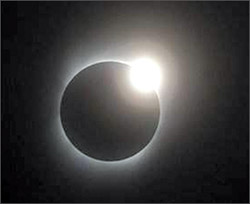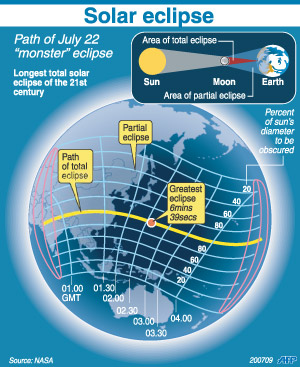|
Solar eclipse:
Celestial mechanics and the Eye of God
Total solar eclipses have struck awe or fear into hearts for
millennia, but scientists are more interested in the unusual mathematics
behind the gold-and-indigo lightshow.
|

A solar eclipse
|
Superstition has always haunted the moment when Earth, Moon and Sun
are perfectly aligned. The daytime extinction of the Sun, the source of
all life, is associated with war, famine, flood and the death or birth
of rulers.
Desperate for an explanation, the ancient Chinese blamed a Sun-eating
dragon. The Vikings believed the culprits were two giant wolves, Skoll
and Hati, which chased the Sun around the sky. Among Indians in South
America, an eclipse was simply, terrifyingly, "the Eye of God."
But a remarkable act of celestial geometry explains it all.
When the Moon glides between Earth and the Sun, it casts a
cone-shaped shadow, called an umbra, that races from West to East.
The Sun is 400 times wider than the Moon, but it is also 400 times
farther away.
Because of the symmetry, the umbra, for those on the planetary
surface, is exactly wide enough to cover the face of the Sun.
 At an eclipse's height, a halo of gold, called a corona, flares
around the darkened lunar disc, while the sky turns an eerie dark blue,
disorienting birds and causing bats to emerge from their roosts in the
belief that night has fallen. At an eclipse's height, a halo of gold, called a corona, flares
around the darkened lunar disc, while the sky turns an eerie dark blue,
disorienting birds and causing bats to emerge from their roosts in the
belief that night has fallen.
Total solar eclipses are exceptional events, and the one that crosses
Asia on Wednesday is especially so.
By eclipse standards, this is "a monster," Espenak and Anderson
estimate in the US magazine Sky & Telescope. We will have to wait until
2132 before the totality duration is beaten.
A total solar eclipse usually occurs every 18 months or so.
Any given spot on Earth's surface will host a total eclipse on
average once every 375 years. Until now, the most-watched eclipse
occurred on August 11, 1999, when the umbra raced from Britain, across
Western Europe, part of the Middle East and India.
The last total solar eclipse was on August 1 2008, and also crossed
China.
The next will be on July 11 2010, but will occur almost entirely over
the South Pacific, where Easter Island - home of the legendary moai
giant statues - will be one of the few landfalls.
That will be wonderful news to "eclipse junkies," an eclectic army
that pursues total eclipses around the world, sometimes hiring seats on
planes or ships to get the best view.
- Paris, AFP
|



